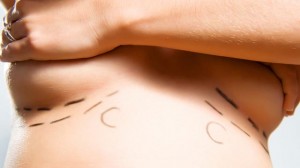Unwanted fat is one of the most common aesthetic concerns for Americans, and the idea of simply sucking out the fat we don’t want sounds like a dream. But liposuction is a significant surgical procedure, and like all surgeries, it requires planning and expertise in order to achieve the safest and most successful outcome. One of the best ways to prepare for liposuction is to do research and educate yourself about the procedure, but be cautious that the information is coming from a reputable source. As a board-certified plastic surgeon who’s been performing liposuction for thirty years, I’m happy to get you started with answers to the most commonly asked liposuction questions.
 How does liposuction work?
How does liposuction work?
Liposuction has various forms, but the type I perform is called tumescent liposuction. Tiny incisions are made around the treatment area, and small tubes are used to first apply a liquid solution, then to use these tubes (called cannulas) to suction out fat from the targeted area.
Where does the fat go after liposuction?
In most cases, the fat extracted from liposuction is simply disposed of, but a procedure which is becoming more and more popular is called fat transfer. After liposuction, some of your fat is purified and then injected into an area where you want to add volume, such as the breasts or precise areas of the face.
Are the results of liposuction permanent?
The results of liposuction are intended to be permanent. What this means is that the fat cells which are removed will not reappear, but if you gain weight in the future, fat can accumulate in surrounding areas and the remaining fat cells in your treatment area can become larger. In other words, while the fat cells are permanently gone, you can once again find yourself with unwanted fat if you gain weight, so your healthy habits will determine whether you maintain your liposuction results.
How much weight will I lose from liposuction?
Liposuction actually has little effect on the number on your scale. It is not a method for weight loss but is instead a way to address specific areas of stubborn fat, also known as body contouring. However, many patients who want to lose weight find great success by reaching their goal weight first and then using liposuction to fine-tine the appearance they’ve worked so hard for.
Can liposuction reduce sagging skin?
Liposuction solely focuses on removing fat, so it will not tighten excess skin. However, some patients benefit from a surgery which combines both fat removal and skin excision, like a tummy tuck or arm lift accompanied by liposuction.
When will I see results from my liposuction?
Although the fat liposuction removes is gone immediately, your results won’t be fully visible until your swelling has subsided. This can take up to several months, although many see some results in just a few weeks depending on the amount of fat removed, so before your surgery, be sure to find out what expectations you should have and when you should be able to tell whether you’re happy with your final results.
Will I have scars after liposuction?
Any surgery will leave a scar, but the scars from liposuction are particularly small and subtle. The incisions only need to be large enough for the tiny tube which removes the fat, so the incisions are very small and are strategically placed in areas that are as discreet as possible.
How long will it take to recover from liposuction?
Most liposuction patients can return to work or most of their daily activities after just a few days to one week. However, every patient’s recovery is unique, so your timeline will depend on your body’s natural healing process, the details of your procedure, your medical needs, and the amount of exertion your job requires.
When it’s done well by an experienced board-certified plastic surgeon, liposuction can be a successful and rewarding way for patients to achieve the precise contours that a healthy diet and exercise routine has not been able to provide. To get started, schedule a plastic surgery consultation with me, Dr. Franklyn Elliott. Or, for more helpful tips and plastic surgery information, follow me on Facebook, Twitter, and Google+.


 Advantage: Fat transfer is a very simple way to enhance the breasts. The injections can be done using local anesthetic, so this procedure is minimally-invasive and carries less risk of an infection, simply because it minimizes the incisions that would otherwise be larger if implants were used to increase the breast size.
Advantage: Fat transfer is a very simple way to enhance the breasts. The injections can be done using local anesthetic, so this procedure is minimally-invasive and carries less risk of an infection, simply because it minimizes the incisions that would otherwise be larger if implants were used to increase the breast size.